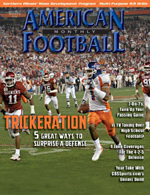AMERICAN FOOTBALL MONTHLY THE #1 RESOURCE FOR FOOTBALL COACHES
|
|
Article Categories
|
Game On! Finding A Football For Your Programby: Jim DouvilleAssistant Coach, Newman Catholic High School, Wausau (WI)© More from this issueOne of my high school coaches once took a break from our two-a-day practice and held up a football. “Can any of you tell me how long a football is?” he asked.
Like most players and coaches, I never knew the exact length of a football (and as a lineman, my regular hands-on experience with footballs in practice was slim to none). We were stumped.
“Eleven and a quarter inches,” he said. “I tell you this because that 11 ¼ inches is the difference between winning and losing. Whichever team controls this very small area of land will be the one who gets to celebrate at the end of any game.”
Of course, our coach used ‘controlling the football’ in a big-picture strategic sense, but we’ll use that anecdote this month as a springboard to a look at the physical....The full article can only be seen by subscribers.
Subscribe today!

|
|
|
NOT A SUBSCRIBER?
Subscribe
now to start receiving our monthly magazine PLUS get INSTANT
unlimited access to over 4000 pages of 100 percent football coaching
information, ONLY available at AmericanFootballMonthly.com!
|
|
|
HOME
|
MAGAZINE
|
SUBSCRIBE
|
ONLINE COLUMNISTS
|
COACHING VIDEOS
|
Copyright 2025, AmericanFootballMonthly.com
All Rights Reserved






